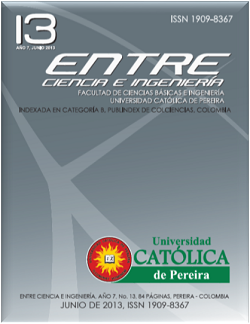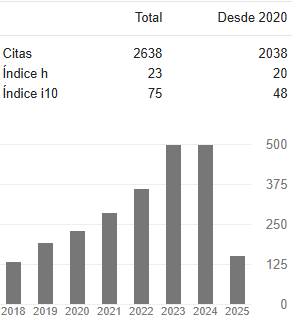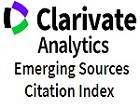Applying a Pilot Scale Electrochemical Reactor, Operating in Potentiostatic Mode for Regenerating Spent Baths Etching
DOI:
https://doi.org/10.31908/19098367.655Keywords:
Etching, Electrochemical Reactor, Electrical Performance, Residence Time, Ceramic Separator.Abstract
When treating the exhausted baths etching industries metalized plastic is used an electrochemical reactor of the filter press type pilot scale as the recovery of hexavalent chromium by oxidation of trivalent chromium on an anode lead. This research focused on the study of a reactor of that type, in order to study their behavior operating in potentiostatic mode of 5 and 7.5 V, with real solutions etching baths. Basic parameters were evaluated for designing electrochemical reactors such as: electrical performance, the conversion reached, the specific productivity and specific energy consumed coupling the electrochemical reactor one and two ceramic separators manufactured 250 kg/cm2 and 0 % starch.
Downloads
References
Smith, W. H. and Foreman, T.”Electrowinning/electrostripping and electrodialysis processes for the recovery and recycle of metals from plating rinse solutions”. Separation Science and Technology, 32 pp. 669-679, 1997.
ElSourougy, M. R., Zaky, E. E., and Aly, H. F.”Transport Characteristics of Ceramic Supported Zirconium-Phosphate Membrane. Journal of Membrane Science, 126, pp. 107-113, 1997.
Guddati, S. L., Holsen, T. M., Li, C. C., Selman, J. R., Mandich, N. V. “The use of a porous ceramic diaphragm for the removal of metallic impurities from chromium plating baths”. Journal of Applied Electrochemistry, 29, pp. 1129-1132, 2004.
Pérez-Herranz, V., Guiñón, J. L., García-Antón, J.;“Ingeniería Electroquímica”. Universidad Politécnica de Valencia. SPUPV-97.897, 2002.
Rutherford, A. “ Análisis de Reactores”. Editorial Alhambra. Madrid. 1973.
González-García, J., Frias, A., Expósito, E., Montiel, V. and Aldaz, A.”Development of a Model for Characterization of Electrochemical Reactors”. Industrial Engineering Chemical Research., 39, pp. 1132-1142, 2000.
Benkhelifa, H., Legrand, J., Legemtilhomme, P., Montillet. A. “Study of the hydrodynamic behaviour of the batch and continuous torus reactor in laminar and turbulent flow regimes by means of tracer methods”. Chemical Engineering Science, 55, pp. 1871-1882, 2000.
Pinheiro-Torres, A., Olivera, F. A. R. and Fortuna, S. P. “Residence time distribution of liquids in a continuous tubular thermal processing system part I: Relating RTD to processing conditions”. Journal of Food Engineering, 35, pp. 147- 163, 1998.
Danckwerts, P. V. “Continuous flow systems. Distribution of residence times”. Chemical Engineering Science”, 2, pp. 1-13, 1953.
Tsamatsoulis. D. and Papayannakos, N. “Partial Wetting Of Cylindrical Catalytic Carriers In Trickle-Bed Reactors”. Chemical Engineering Science, 49, pp. 523-529, 1994.
Hasson, D., Drak, A., Komlos, C., Yang, Q., Semiat, R. “Detection of fouling on RO modules by residence time distribution analyses”. Desalination, 204, pp.132-144, 2007.
Doherty, T., Sunderland, J. G., Roberts, E. P. L. and Pickett, D. J. “Electrodeposition of copper ions on fixed bed electrodes: kinetic and hydrodynamic study”. Electrochimica Acta, 41, pp. 519-526, 1996.
Zhang, T., Wan, T., Wang, J. “Flow patterns and wall stresses in a moving granular filter bed with an asymmetric louvered-wall and obstacles”. Chemical Engineering and Processing, 44, pp. 1221- 1227, 2005.
Melo, P. A., Pinto, J. C., Evaristo C., Biscaia, J. “Characterizing a tubular polymerization reactor by washout initiator perturbation”. Chemical Engineering Science, 56, pp. 2703- 2713, 2001.
Sánchez, E., Mestre, S., Pérez-Herranz, V., Reyes, H., Añó, E. “Membrane electrochemical reactor for continuous regeneration of spent chromium plating baths”. Desalination, 200, pp. 668-670, 2006.
M. García-Gabaldón, V. Pérez-Herranz, Henry Reyes. “Regeneration of Hexavalent Chromium from a Simulated Rinse Etching Solution Using an Electrochemical Reactor With Two Compartments Separated by a Ceramic Membrane”. Int. J. Electrochem. Sci., 6, pp 1493 – 1507, 2011.
Pérez-Herranz, V, et al. Chisa 2004. “Regeneration of etching solutions using electrochemical reactors provided with porous ceramic diaphragms”. 16th International Congress of Chemical and Process Engineering, Czech Society of Chemical Engineering, Praga, 2004.
González-García, J., Montiel, V. and Aldaz, A. “Electrochemical characterisation of platinum nanoparticles prepared by microemulsion: how to clean them without loss of crystalline surface structure”. Industrial Engineering Chemical Research., 37, pp. 4501-4511, 1998.
Pérez-Herranz, V., Guiñón, J. L. and García-Antón, J. “Electrochemical recovery of zinc from the spent pickling baths coming from the hot dip galvanizing industry. Potentiostatic operation”. Journal Chemical Engineering Science 54, pp 1667- 1675, 1999.
Mandich, N. V. Li, C. C., and Selman, J. R. “Recovery of metallic impurities from chromium plating solutions by electromigration”. Plating and Surface Finishing, 84, pp. 82-90, 1997.
García-Gabaldón, M., Pérez-Herranz, V., García-Antón, J., Guiñón, J. L. “Electrochemical recovery of tin from the activating solutions of the electroless plating of polymers: Galvanostatic operation”. Separation and Purification Technology. 45, pp. 183-191, 2005.
Bazan, J. C., and Bisang, J. M. “Potential and current distribution in porous electrodes under charge-transfer kinetic control”. Journal of Applied Electrochemistry, 34, pp. 501-506, 2004.
Downloads
Published
Issue
Section
License
Copyright (c) 2019 Entre ciencia e ingeniería

This work is licensed under a Creative Commons Attribution-NonCommercial 4.0 International License.



















